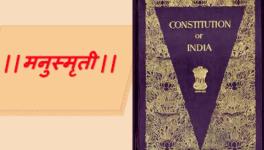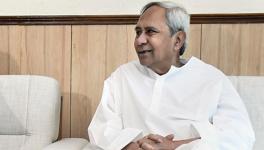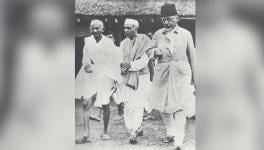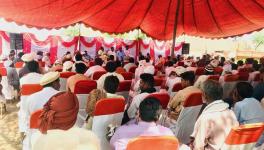How to Fight the Eclipse After a Bhumi Pujan
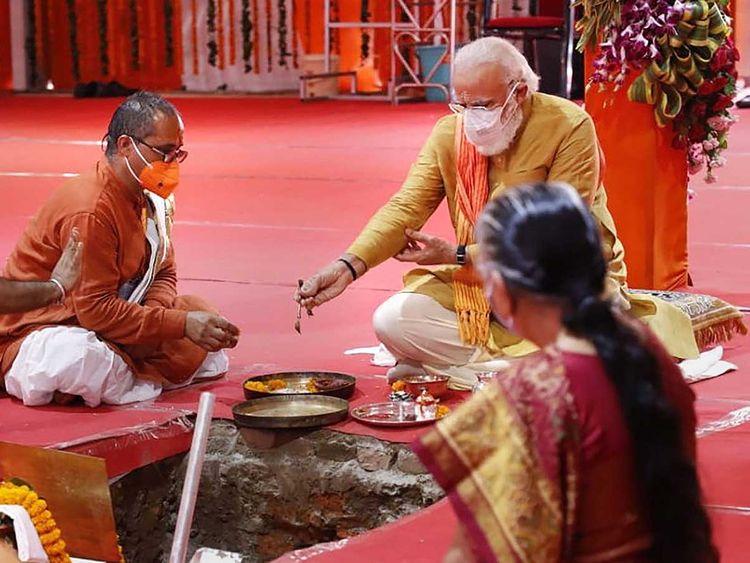
Image Courtesy: PTI
On the eve of the Bhumi Pujan at Ayodhya, the All India Muslim Personal Law Board (AIMPLB) once again punched above its weight. Despite having reiterated time and again that it will “accept the Supreme Court’s verdict” on the dispute, yet it delivered a cryptic tweet, which it then deleted, that had a somewhat intimidating tone:
“#BabriMasjid was and will always be a Masjid. #HagiaSophia is a great example for us. Usurpation of the land by an unjust, oppressive, shameful and majority appeasing judgment can’t change its status. No need to be heartbroken. Situations don’t last forever.#ItsPolitics
The AIMPLB retains the Urdu version of this statement online. The reference to Turkey’s Hagia Sophia in the English version may well be taken as a provocation. In 1934, the Hagia Sophia was declared a museum by the Kemalist regime, and in 2020 it was declared a mosque by the Erdogan regime, a move that has invited widespread opprobrium.
The many infirmities and flaws of the Supreme Court judgment of 9 November 2019 have already been articulated by opinion writers and legal minds. One should, therefore, see the AIMPLB’s intransigence, which comes in the face of the prevailing disturbing majoritarianism, as a very disturbing portend for the future. Competitive supremacism of all kinds is unacceptable and does not hold the promise a better future.
What is worrying about the 5 August event in Ayodhya is its timing and the manner in which the Bhumi Pujan was carried out. The day marked the first anniversary of the abrogation of Article 370 in Jammu and Kashmir, and the changeover of an entire state into a prison. If on that date the Centre had conducted its ceremony along with laying the foundation stone for the proposed mosque (or a complex with a mosque, hospital, resource centre, etc.), it would have sent out a message closer to conciliation and harmony. At least then it would have been more in keeping with the sarva dharm sambhav content of India’s pluralistic secularism. Such a gesture, of inaugurating a temple and a mosque, even if it was by a state functionary, would have been more in conformity with the spirit of the Constitution as well. Or, at the very least, it would have been a more rashtriya (national) event.
Yet things are not unfolding in this manner. Instead, the plot of five acres of land allotted to the Muslims some 25 kilometres from Ayodhya town, which the chief minister has more or less refused to visit, sends a metaphorical and geo-spatial message that the Muslim component of the nation is pariah, a mlechha, one to be excluded and segregated, and therefore subordinated and subjugated. This exclusion is a display of majoritarianism and makes the 5 August event a marker of nothing less than triumphalism.
Even the AIMPLB and other Muslim bodies would have done better by raising these issues and objections rather than suggesting that what was settled in November 2019 can be unsettled now or in some distant future. The irony here is that one has to remind the AIMPLB, its supporters and the conservative Muslims in general, that revenge and righting historical wrongs is uncalled for.
Two, there is a conjoint critical aspect that relates to those Hindus who are re-circulating the falsehood that the Babri mosque was constructed by demolishing a temple. They too are fomenting trouble. The Supreme Court verdict has not only rejected such an assertion, it has also called the demolition of the Babri mosque a “criminal” act and lamented that they have not been punished yet.
Three, there is a growing section of neo-majoritarians among the Hindus today: those who pretend to be the rational correctives of the follies of the liberal-secular-leftists. They need to be reminded that rejoicing at the punishment of the culprits of the Bombay blasts of March 1993, and showing no grudge towards the culprits of the communal violence preceding the blasts, is sheer and utter duplicity. This will be seen as majoritarian privilege and minority persecution. What they are promoting is faith-based graded citizenship through the route of discriminatory justice delivery.
Four, it turns out that even the liberal-secular-left have some follies to admit to. The arguments made on the basis of history and archaeology in the 1980s, when the Ramjanmbhoomi movement was reaching its pitch, especially now, in retrospect, have not worked. The principle of monument-preservation and constitutional provisions ought to have been their guiding lights. The representatives of Hindutva, after one Bhumi Pujan in place, have already reiterated their resolve to gun for the mosques at Kashi and Mathura, and there the history and archaeology arguments will not offer even as much support as they did in the case of Babri. In this context, those who invoked the shariat to protect Babri cannot argue for the status quo, nor can those who invoked history and archaeology. The fundamental flaw appears to be in our institutions, which have been unable to act as per the rule of law and the Constitution. It is now seriously in doubt whether these two structures will be protected by the force of law against the whims of majoritarian supremacism.
In many ways, India is moving fast towards becoming like Israel and Pakistan, which the Oxford historian Faisal Devji rightly described as the “Muslim Zion”. While Israel privileges Jew citizens over non-Jews, including the Arabs—the original inhabitants, moolnivasis if you will, of the region—Pakistan, with a faith-based citizenship, keeps hounding not only the non-Muslims, but also members of Muslim sects such as the Shias and Ahmadiyas. This is a problem inherent to all theocratic states. Such states question the faith of those citizens who dissent, or even appear to dissent, against it, threatening to rob them of citizenship and its entitlements. Many other countries, such as Turkey and Brazil, are also moving in this direction. One can only wait to see what will happen in India.
While it is up to the Supreme Court and relevant institutions to deal with this moment in history, in whatever manner they wish to, yet the entire nation is witness to the cumulative strength of Hindutva zealots emboldened by the strength of their numbers and by the complicity of institutions. This has been in making since long, and it gained greater momentum in recent decades. Saumya Saxena, in her 2018 essay, had this to say about the journey of our apex judiciary:
“Thus, at their best the Hindutva judgments [1995] paved the way for a benign celebration of Hinduism’s secularity; at their worst they rendered minorities significantly more vulnerable. Hindutva’s ‘electoral’ victory granted salience to the persecution of minorities through draconian legislation... [such as penalising the instant triple divorce and also the CAA], and a hostile executive [anti-Romeo squads], but, significantly, the ‘judicial’ precedent is fast becoming the preferred route to law-making. This therefore cannot be written off simply as an unholy alliance between political parties and courts, or a compromise on the separation of powers, because the concern here is not with judicial overreach or compromise, but the slippery slope that the Hindutva judgments enabled campaigning through courts”.
Moreover, in the 1980s, the AIMPLB brand of forces among the Muslims made their own contributions of fodder to rising majoritarianism. On 15 January 1986, in a session of the Momin Conference at the Siri Fort Auditorium in Delhi, the then prime minister Rajiv Gandhi announced his intention to amend the law to nullify the Supreme Court’s April 1985 verdict in favour of Shah Bano. A bill was introduced in March and it became the Muslim Women (Protection of Rights on Divorce) Act in May 1986. In January 1986, there were strident Muslim protests against the progressive verdict, which had granted Shah Bano, a Muslim woman, alimony after her divorce.
The approach of the conservative Muslims became pretty clear from the Urdu memoir, Karwan-e-Zindagi, published in 1988 by Maulana Abul Hasan Ali Miyan Nadvi (1914-1999). In volume 3, chapter 4, page 134, Nadvi clearly narrates that it is he who had persuaded Gandhi not to accept the proposition that many Islamic countries have already reformed their personal laws. Nadvi’s narration is triumphant; he rejoices in the successful accomplishment of his effort to stymie a similar reform in India. He says his persuasion had a particular psychological impact on Gandhi and that his “arrow precisely hit the target—woh teer apney nishaaney par baitha”. On page 157 comes Nadvi’s candid “confession”: “Our mobilization for protecting the Shariat in 1986 resulted into complicating the issue of Babri Masjid and vitiated the atmosphere in a big way—is ne fiza mein ishte’aal wa izteraab paida karney mein bahut bara hissa liya,” he writes.
For further substantiation, one must read Nadvi’s memoir in Nicholas Nugent’s book, Rajiv Gandhi: Son of a Dynasty, published by BBC Books, in 1990. On page 187 Nugent writes:
“...a decision had been taken by the Congress High Command in the early 1986 to ‘play the Hindu card’ in the same way that the Muslim Women’s bill had been an attempt to ‘play the Muslim card’... Ayodhya was supposed to be a package deal... a tit for tat for the Muslim women’s bill... Rajiv played a key role in carrying out the Hindu side of the package deal by such actions as arranging that pictures of Hindus worshipping at the newly unlocked shrine be shown on television.”
The lock was opened within an hour of the judgment being delivered by the district court of Faizabad on 1 February 1986. As said earlier, the deal between the Prime Minister, the Muslim clergy and the Momin Conference’s Ziaur Rahman Ansari (who died in 1992) had already been struck in January 1986. There is a reference to this in his biography, Wings of Destiny, 2018, written by his son Fasihur Rahman. Yet, a nagging question remains: who wanted to open the locks, and why? After all, the elections were four long years away and so Gandhi did not have a direct electoral stake in the event.
The millennial Muslim conservatives who are endorsing the reactionary viewpoint today have to be reminded of these follies of the 1980s. For long, India’s liberals have remained rather paternalistic and somewhat “tolerant” of the truants among Muslim unprogressives. The need of the hour is to speak out against both the rabid majoritarians and the “minoritarians” too. In these dark and repressive times, this is possibly the only way out. Else, India going the Israel-Paksitan way may become unavoidable. Corporate greed and crisis-ridden global capitalist imperialism have only exacerbated this crisis. Institutions, including the Opposition, have fallen. What remains to be seen is if their crisis his irretrievable.
The author teaches modern and contemporary Indian history at AMU. The views are personal.
Get the latest reports & analysis with people's perspective on Protests, movements & deep analytical videos, discussions of the current affairs in your Telegram app. Subscribe to NewsClick's Telegram channel & get Real-Time updates on stories, as they get published on our website.









